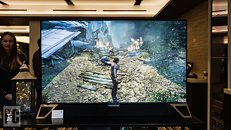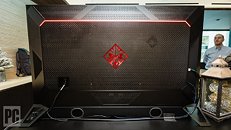Raevenlord
News Editor
- Joined
- Aug 12, 2016
- Messages
- 3,755 (1.18/day)
- Location
- Portugal
| System Name | The Ryzening |
|---|---|
| Processor | AMD Ryzen 9 5900X |
| Motherboard | MSI X570 MAG TOMAHAWK |
| Cooling | Lian Li Galahad 360mm AIO |
| Memory | 32 GB G.Skill Trident Z F4-3733 (4x 8 GB) |
| Video Card(s) | Gigabyte RTX 3070 Ti |
| Storage | Boot: Transcend MTE220S 2TB, Kintson A2000 1TB, Seagate Firewolf Pro 14 TB |
| Display(s) | Acer Nitro VG270UP (1440p 144 Hz IPS) |
| Case | Lian Li O11DX Dynamic White |
| Audio Device(s) | iFi Audio Zen DAC |
| Power Supply | Seasonic Focus+ 750 W |
| Mouse | Cooler Master Masterkeys Lite L |
| Keyboard | Cooler Master Masterkeys Lite L |
| Software | Windows 10 x64 |
Product context: HP showcased their new and upcoming Omen X Emperium 65 at CES, an NVIDIA BFGD (Big Format Gaming Display) with all the features the company deems premium and attractive to gamers: 4K resolution, a huge, 65" diagonal AMVA panel, HDR (1,000 nits of peak luminance and 95 percent of the DCI-P3 color gamut) , G-Sync, and 120 - 144Hz refresh rate (144 Hz is overclocked) with a gray-to-gray response time is rated for 4ms. It features an incorporated sound bar with 120 W of power and three amps. An integrated NVIDIA Shield makes an appearance as well as a multimedia juggernaut solution. All of this in a $4,999 body, launching in February 2019.
Thoughts: Rollback. A $4,999 price-tag. Maybe this is just me, but NVIDIA seems to be finally introducing their BFGDs at the worst possible time, considering the company has just formally announced that their GeForce graphics cards would be finally supporting VESA's VRR (Variable Refresh Rate) standard. This brings with it FreeSync support - for monitors and, we'd expect, TV's as well, considering that the driver solution will be toggable by users even in a non-NVIDIA certified display.




This means that any televison that supports the standard (a part of the HDMI 2.1 specification, of which there are supporting products already announced, such as LG's 2019 OLED lineup) should be able to provide G-Sync's buttery-smoothness... With no added "G-Sync premium" and, at least for LG's products, the improved overall image quality of an OLED (with a reduced maximum refresh rate of 120 Hz for these panels, it bears mentioning). Whether or not the market will want NVIDIA's product, will as always, belong to users' wallets. But I'd say that the delays and NVIDIA's decision to (finally, and an almost obligatory one) support VRR have hurt the market's reception for the BFGD product vision.
View at TechPowerUp Main Site
Thoughts: Rollback. A $4,999 price-tag. Maybe this is just me, but NVIDIA seems to be finally introducing their BFGDs at the worst possible time, considering the company has just formally announced that their GeForce graphics cards would be finally supporting VESA's VRR (Variable Refresh Rate) standard. This brings with it FreeSync support - for monitors and, we'd expect, TV's as well, considering that the driver solution will be toggable by users even in a non-NVIDIA certified display.




This means that any televison that supports the standard (a part of the HDMI 2.1 specification, of which there are supporting products already announced, such as LG's 2019 OLED lineup) should be able to provide G-Sync's buttery-smoothness... With no added "G-Sync premium" and, at least for LG's products, the improved overall image quality of an OLED (with a reduced maximum refresh rate of 120 Hz for these panels, it bears mentioning). Whether or not the market will want NVIDIA's product, will as always, belong to users' wallets. But I'd say that the delays and NVIDIA's decision to (finally, and an almost obligatory one) support VRR have hurt the market's reception for the BFGD product vision.
View at TechPowerUp Main Site



 ( apart from a Couple for Linus to play with)
( apart from a Couple for Linus to play with)


